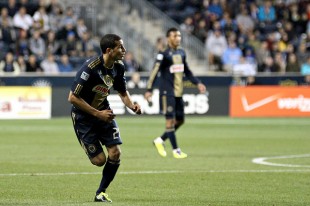Photo: Paul Rudderow
Philadelphia Union’s development system took a giant leap forward Saturday night.
Saturday night’s appearances by midfielders Zach Pfeffer and Morgan Langley marked the first time a true local product has played in a regular season game for the Union.
Until now, Philly-area players haven’t been represented at PPL Park in a game that mattered. LaSalle product Ryan Richter is on the roster, but he hasn’t played yet after a conversion to defender. Temple alum J.T. Noone signed with the team last year, but he was cut before playing in a regular season game and spent this season at Harrisburg. Pfeffer had signed with the Union at age 15, but he had (understandably) yet to play. Even attacker Levi Houapeu had some tenuous local ties, having spent a season playing for AC Reading United, the Union’s current Premier Development League affiliate, but he hadn’t featured all year (and won’t, ostensibly due to injury). Well-known Philly-area products like Bobby Convey and Jeremiah White were passed over by the Union.
Maybe the closest the Union had to a local product who actually plays was right back Sheanon Williams, who spent a season with the Harrisburg City Islanders, a Union-affiliated club in the United Soccer Leagues. True, his signing and subsequent terrific performance was huge for the Union-Harrisburg relationship, and it probably helped lay the groundwork leading to the Langley signing. But as much as fans have come to love Williams, he’s not from the Delaware Valley. He’s from Massachusetts.
Pfeffer’s a local kid who came up through the highly regarded FC Delco program. Richter grew up in Warminster and played college ball in Philly. Langley spent four years playing at Swarthmore College. These guys are truly local. They grew up in our neighborhoods or, in Langley’s case, went to the local small college.
If you want to build a talent pipeline to the local youth, that’s one path the Union need to own.
It’s not the only path, of course. You can’t dismiss the importance of the Union’s relationships with Harrisburg and Reading United.
But to really step up and build a local talent pipeline anywhere near what European and South American clubs have, the Union needed to show they were serious about local products actually getting playing time. Until Saturday, none had.
MLS’s player development purgatory
Other Major League Soccer clubs have bought in big to the youth development concept in recent years. FC Dallas recently signed their sixth player from their youth academy, while D.C. United’s starting lineup often includes three local products, including last year’s MLS rookie of the year, Andy Najar. Real Salt Lake has gone even further by dropping $20 million on a youth training and residential facility in Arizona.
Taking such steps is key for MLS clubs if the league is to cement itself not just as a world class soccer league but also as a top North American professional league in any sport. But the transition isn’t easy.
MLS exists in a purgatory of player development models, straddling the vast chasm separating major North American pro sports and top European soccer leagues. In Europe, the player development and acquisition model is based almost entirely on straight signings. If you find the guy first, you sign him, no matter how old. Simple as that.
In North American sports leagues, amateur drafts serve as the primary initial player acquisition tool. All pro football players come through the college ranks first, as do most pro basketball players. In baseball and hockey, it’s fairly well split between those who play college ball and those who come out straight from high school. Minor leagues in baseball, hockey, and now basketball further serve as feeder programs.
But in none of these North American leagues do kids sign with teams before graduating high school, with the exception of Latin American players signing with Major League Baseball teams (a practice that draws some criticism, by the way).
MLS has had to straddle those models, with one foot in each world. It began with (and still has) an amateur draft for post-scholastic players, because that’s what we do in U.S. sports. But that doesn’t fly for soccer, where the top players effectively grow up in a professional training environment from the time they’re children.
These days, soccer coaches and executives have come to accept and even vocalize that the American college sports model simply isn’t as good for player development as the European model, with its youth academies. As more MLS clubs turn to youth academies, we could eventually see the gradual phasing out of the league’s amateur draft in favor of a local development model, built on teams identifying and signing young, local players.
Back to the future
Bottom line: Alongside the advent of soccer-specific stadiums, there is no single thing as important to MLS’s future as youth development.
If there’s anything Union manager Peter Nowak and top assistant John Hackworth have done best, it’s to establish the Union’s local youth ties. Until Saturday, one big piece was conspicuously missing from that.
Now that two local products have finally appeared in a game that mattered (against the first place team, at that), every teenage soccer player should now know they too could some day play for the Union. The talk isn’t just talk. It’s not just public relations. It’s real. Every soccer-playing kid in this region will know this. That will put the Union in the driver’s seat to sign them, and it may even sell some more tickets.
But most importantly, it will connect the team even further with its community. There’s no hometown team like the one with hometown players.


Your last 2 lines are classic. Sporting KC has two starting XI players (Matt Besler and Seth Sinovic) that are products of local development (prior to true training academies) and when I take friends to games that haven’t been before and point out these guys are from our local suburbs, they are really impressed. Often you can’t say that about your local MLB or NFL team.
Good article Dan. Who do you think will be signed out of the Academy teams? Darius Madison or Christian Hernandez? Any one else?
Im disappointed Jimmy McGauglin went to college, he looked good.
Thanks, guys. Not sure who will be signed. I personally haven’t followed the Academy teams close enough this year. But I think what the Ethan White signing in DC shows is that a guy can go to college for a year after having been in the academy program and still come back and sign with the team as a homegrown player. So a guy who goes to college could still be aligned with the team and come back home to play at any time, if he’s good enough.